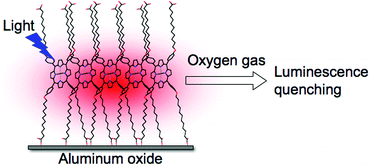Optical oxygen-sensing properties of porphyrin derivatives anchored on ordered porous aluminium oxide plates†‡
Abstract
An optical oxygen-sensing activity of anchored

Maintenance work is planned for Wednesday 1st May 2024 from 9:00am to 11:00am (BST).
During this time, the performance of our website may be affected - searches may run slowly and some pages may be temporarily unavailable. If this happens, please try refreshing your web browser or try waiting two to three minutes before trying again.
We apologise for any inconvenience this might cause and thank you for your patience.
* Corresponding authors
a
Division of Natural Science and Ecological Awareness, Graduate School of Humanities and Sciences, Nara Women's University, Kita-uoya-nishi-machi, Nara, Japan
E-mail:
yano@cc.nara-wu.ac.jp
Fax: +81-742-20-3392
Tel: +81-742-20-3392
b Department of Applied Chemistry, Oita University, Dannoharu 700, Oita, Japan
c Biomimetics Research Center, Doshisha University, Kyo-Tanabe, Kyoto, Japan
d Department of Crystalline Materials Science, Graduate School of Engineering, Nagoya University, Furo-cho, Chiusa-ku, Nagoya, Aihci, Japan
e Graduate School of Materials Science, Nara Institute of Science and Technology, 8916-5, Takayama, Ikoma, Nara, Japan
f Aerodynamics Research Group, Institute of Space Technology and Aeronautics, Japan Aerospace Exploration Agency, 7-44-1, Jindaiji Higashi Chofu City, Tokyo, Japan
g Department of Aeronautics and Space Engineering, Tohoku University, 01 Aoba, Aoba-ku, Sendai, Japan
An optical oxygen-sensing activity of anchored

 Please wait while we load your content...
Something went wrong. Try again?
Please wait while we load your content...
Something went wrong. Try again?
N. Araki, Y. Amao, T. Funabiki, M. Kamitakahara, C. Ohtsuki, K. Mitsuo, K. Asai, M. Obata and S. Yano, Photochem. Photobiol. Sci., 2007, 6, 794 DOI: 10.1039/B618030B
To request permission to reproduce material from this article, please go to the Copyright Clearance Center request page.
If you are an author contributing to an RSC publication, you do not need to request permission provided correct acknowledgement is given.
If you are the author of this article, you do not need to request permission to reproduce figures and diagrams provided correct acknowledgement is given. If you want to reproduce the whole article in a third-party publication (excluding your thesis/dissertation for which permission is not required) please go to the Copyright Clearance Center request page.
Read more about how to correctly acknowledge RSC content.
 Fetching data from CrossRef.
Fetching data from CrossRef.
This may take some time to load.
Loading related content
